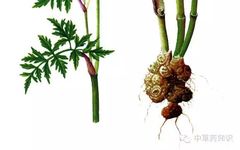Herb Name: Chuanxiong (川芎) Alias: Xiongqiong (芎穷) Harvesting and Processing: Harvest the rhizome from late May to early June in the second year after planting. Shake off the soil, remove stems and leaves, and dry. For plain cultivators, harvesting 4-5 days after the “Xiaoman” (小满) solar term is optimal, while mountain cultivators often harvest in August to September. The rhizome is dug out, cleaned of stems, leaves, and soil, washed, dried in the sun or baked, and then the fibrous roots are removed using a pounding device.Medicinal Part: Rhizome Origin: Sichuan, Yunnan, Guizhou, Guangxi Family: Apiaceae Original Plant: Chuanxiong (川芎) Plant Description: A perennial herb, growing 40-70 cm tall. The entire plant has a strong aroma. The rhizome is irregularly nodular and bulbous, with numerous fibrous roots at the lower end. The stem is erect, cylindrical, hollow, with longitudinal grooves on the surface. The lower nodes of the stem are swollen into a disc shape (commonly known as Lingzi), while the nodes above the middle are not swollen.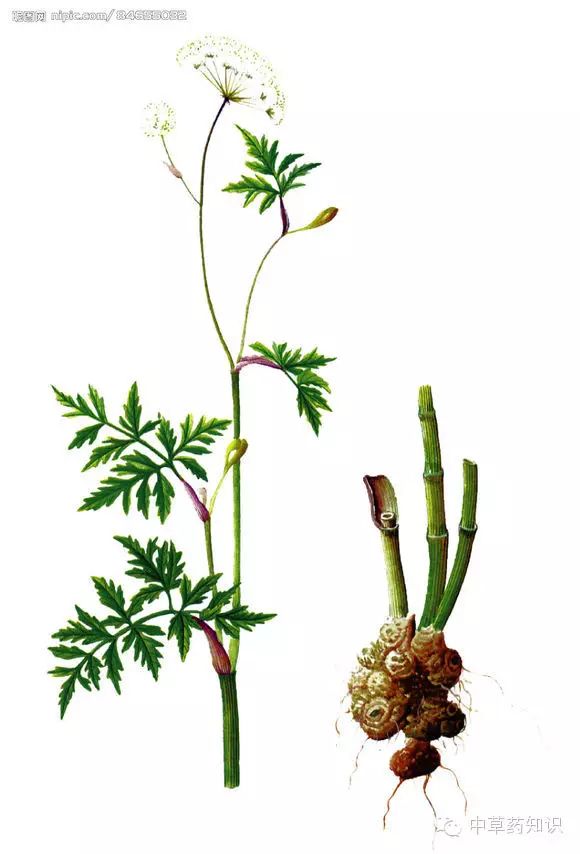 The lower leaves of the stem have petioles 3-10 cm long, which expand into a sheath at the base; the leaf blades are ovate-triangular, 12-15 cm long and 10-15 cm wide, with three to four times pinnately compound lobes, 4-5 pairs of leaflets, ovate-lanceolate, 6-7 cm long and 5-6 cm wide, with the terminal lobes linear-lanceolate to oblong, 2-5 mm long and 1-2 mm wide, with a small pointed tip, and sparse short soft hairs only on the veins; the upper leaves of the stem gradually simplify.
The lower leaves of the stem have petioles 3-10 cm long, which expand into a sheath at the base; the leaf blades are ovate-triangular, 12-15 cm long and 10-15 cm wide, with three to four times pinnately compound lobes, 4-5 pairs of leaflets, ovate-lanceolate, 6-7 cm long and 5-6 cm wide, with the terminal lobes linear-lanceolate to oblong, 2-5 mm long and 1-2 mm wide, with a small pointed tip, and sparse short soft hairs only on the veins; the upper leaves of the stem gradually simplify.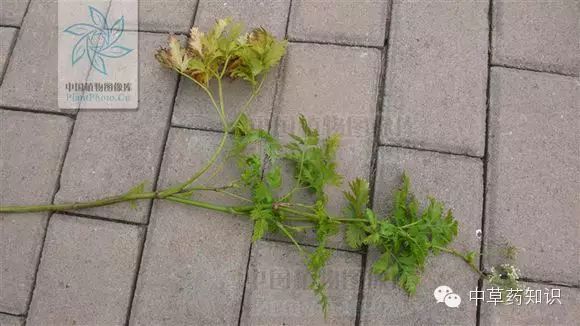 The compound umbel is terminal or lateral, with 3-6 linear involucral bracts, 0.5-2.5 cm long; the rays are 7-20, unequal in length, 2-4 cm long; the small umbellate flowers have 10-24 flowers; the small involucral bracts are 2-7, linear, slightly purplish, covered with soft hairs, 3-5 mm long; the calyx teeth are undeveloped; the petals are white, obovate to elliptical, with a short pointed protrusion at the tip, curved inward; stamens 5, anthers light green; styles 2, 2-3 mm long, curved downward.
The compound umbel is terminal or lateral, with 3-6 linear involucral bracts, 0.5-2.5 cm long; the rays are 7-20, unequal in length, 2-4 cm long; the small umbellate flowers have 10-24 flowers; the small involucral bracts are 2-7, linear, slightly purplish, covered with soft hairs, 3-5 mm long; the calyx teeth are undeveloped; the petals are white, obovate to elliptical, with a short pointed protrusion at the tip, curved inward; stamens 5, anthers light green; styles 2, 2-3 mm long, curved downward.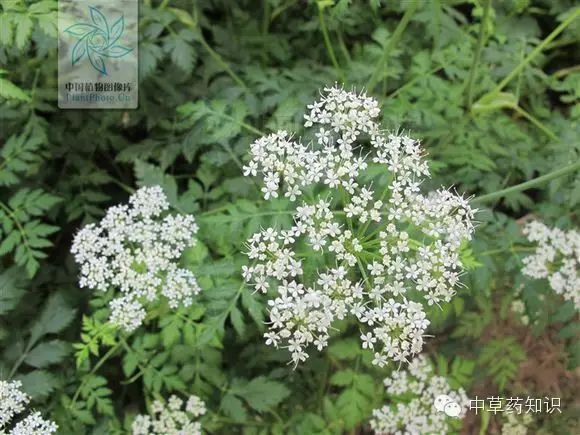 The immature fruit is flattened on both sides, 2-3 mm long and about 1 mm wide; there are 1-5 oil ducts in the dorsal groove, 2-3 oil ducts in the lateral grooves, and 6-8 oil ducts on the fused surface. The flowering period is from July to August, and the immature fruit period is from September to October. Chuanxiong (川芎) Slice Characteristics: The rhizome is irregularly nodular and bulbous, with a diameter of 1.5-7 cm. The surface is yellow-brown to yellow-brown, rough and wrinkled, with numerous parallel raised nodes; the top has a round, depressed stem scar, and the underside and nodes have numerous small tuberous root scars. The texture is firm and not easily broken, with a yellow-white or gray-yellow cross-section, featuring wavy ring patterns, and scattered yellow-brown oil spots. The aroma is strong and distinctive, with a bitter, spicy taste, slightly sweet aftertaste, and a numbing sensation on the tongue.
The immature fruit is flattened on both sides, 2-3 mm long and about 1 mm wide; there are 1-5 oil ducts in the dorsal groove, 2-3 oil ducts in the lateral grooves, and 6-8 oil ducts on the fused surface. The flowering period is from July to August, and the immature fruit period is from September to October. Chuanxiong (川芎) Slice Characteristics: The rhizome is irregularly nodular and bulbous, with a diameter of 1.5-7 cm. The surface is yellow-brown to yellow-brown, rough and wrinkled, with numerous parallel raised nodes; the top has a round, depressed stem scar, and the underside and nodes have numerous small tuberous root scars. The texture is firm and not easily broken, with a yellow-white or gray-yellow cross-section, featuring wavy ring patterns, and scattered yellow-brown oil spots. The aroma is strong and distinctive, with a bitter, spicy taste, slightly sweet aftertaste, and a numbing sensation on the tongue.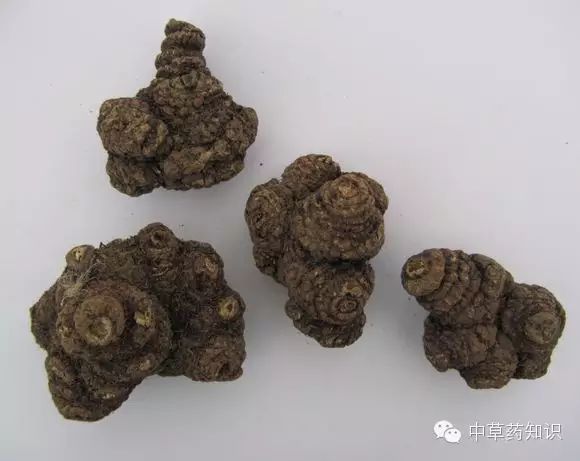
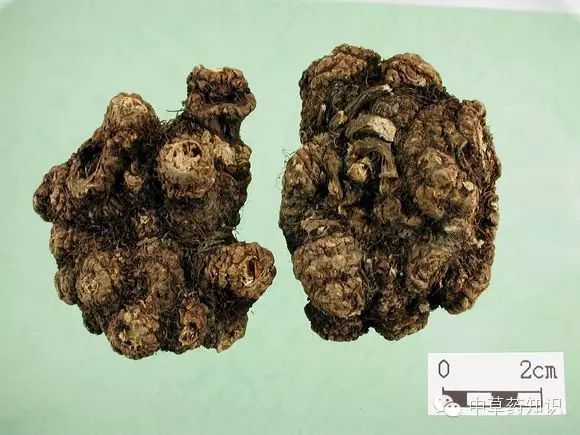
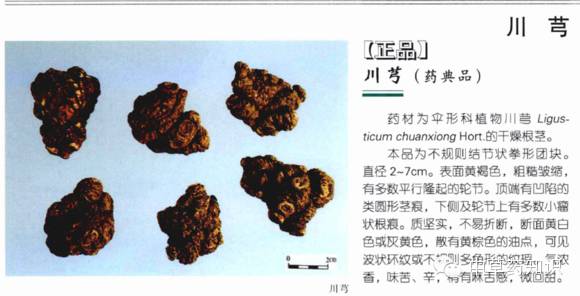
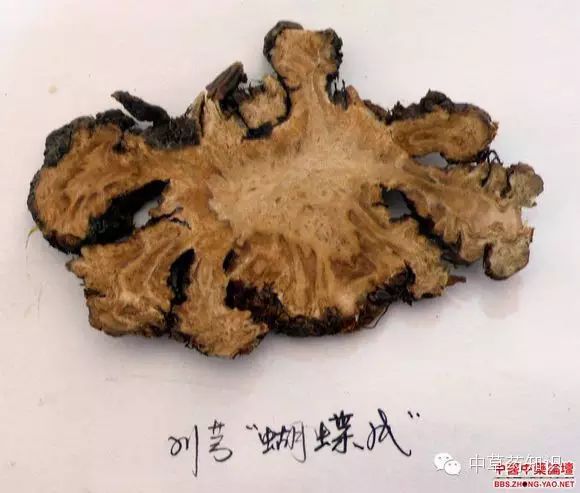 Choose those that are large, plump, firm, with a yellow-white cross-section, high oil content, and strong aroma. Chuanxiong (川芎) Properties: [Compendium of Materia Medica] Chuanxiong (川芎) is pungent and warm. It is indicated for wind stroke with headache, cold bi syndrome with muscle spasms, traumatic injuries, and women’s blood stasis leading to infertility.It is pungent, slightly warm, and enters the liver meridian (足厥阴肝经). It promotes the flow of qi and blood, alleviates wind and stagnation, relieves pain, and breaks up blood stasis. Chuanxiong (川芎) is pungent and ascending, good for relieving liver qi stagnation, breaking up stasis, alleviating pain, and is suitable for those with liver qi stagnation. Its indications include: carbuncles, furuncles, goiter, hemorrhoids, and various sores, as well as stopping bleeding from the mouth, nose, teeth, and urine.[Origin] Grown in Sichuan, Shaanxi, and various regions in Jiangnan, it is a perennial herb, either wild or cultivated, with a tuberous rhizome, pungent in taste, used medicinally.[Taste and Properties] Pungent, warm, and non-toxic.[Indications] Chuanxiong (川芎) is a key herb for promoting qi and blood circulation, with functions to regulate qi, relieve stagnation, enter the liver to regulate blood, ascend to the head, and descend to the blood sea, indicated for headaches and all conditions of qi and blood stagnation in women, abdominal pain, weakness in the lower back and legs, breaking up old blood, nourishing new blood, and dispelling wind.[Additional Notes] It alleviates cold pain in the brain, facial wind, excessive tears, sudden dizziness, cold air, abdominal pain, sudden swelling and pain, and lateral flank pain.[Zhenquan] Weakness in the knees, hemiplegia, retained placenta.[Daming] It addresses all types of wind, qi, all forms of fatigue, all blood issues, tonifies the five fatigues, strengthens muscles and bones, regulates various pulses, breaks up stasis and old blood, nourishes new blood, and treats coughing blood, nosebleeds, hematuria, cerebral palsy, carbuncles, furuncles, goiter, hemorrhoids, and various sores, promoting healing and dispelling stasis and phlegm blood.[Haogu] It dispels liver wind, nourishes liver blood, moistens dryness, and benefits liver deficiency.[Rongchuan] Chuanxiong (川芎) is more pungent and bitter than Angelica (当归), with a strong wood-fire nature, bitter and pungent, having the ability to generate blood, and is not soft and moist, thus specifically promoting the flow of heart and liver blood. The bitterness represents the flavor of fire, and the combination of bitterness and pungency indicates warmth and blood-generating properties. Bitter without pungency is cool and primarily promotes blood loss, while warmth is the yang within yin, thus it enters the liver meridian, and the root also promotes upward movement, dispersing wind-cold, qi stagnation, and blood stasis, alleviating cold and heat pain, and addressing women’s menstrual issues. [Dosage] Generally, 9-15 grams.[Contraindications] Its dispersive nature is not suitable for long-term use, as it can harm the liver; avoid with Huanglian (黄连) and Fuzhu (伏雌黄).[Preparation] Chuanxiong (川芎): Remove impurities, separate large and small pieces, soak in water, dry, moisten, then slice and dry. Wine-prepared Chuanxiong: Take Chuanxiong slices, spray evenly with yellow wine, slightly moisten, stir-fry in a pot until slightly charred, then cool (for every 100 jin of Chuanxiong slices, use 12 jin 8 liang of yellow wine).[Taste and Properties] Pungent; warm[Meridian Entry] Enters the liver, gallbladder, and pericardium meridians[Functions and Indications] Activates blood and dispels stasis; regulates qi and relieves stagnation; dispels wind and alleviates pain. Indicated for menstrual irregularities; dysmenorrhea; postpartum stasis and pain; masses and lumps; chest and flank pain; headaches and dizziness; wind-cold-damp bi syndrome; traumatic injuries; carbuncles and sores.[Dosage and Administration] Internal use: decoction, 3-10 g; powdered, 1-1.5 g per dose; or in pills or powders. External use: appropriate amount, powdered for sprinkling; or decoction for gargling.[Cautions] Contraindicated for those with yin deficiency and excess fire, as well as those with upper excess and lower deficiency and weak qi.1. “Compendium of Materia Medica”: Bai Zhi (白芷) is a guiding herb. Avoid Huanglian (黄连).2. “Essentials of Materia Medica”: Long-term use can disperse true qi.3. “Materia Medica of the New Era”: Avoid Huangqi (黄芪), Shanzhuyu (山茱), and Langdu (狼毒). Avoid Nitrate, Talc, and Huanglian (黄连). Counteracts with Li Lu (藜芦).4. “Commentary on Materia Medica”: For patients with upper excess and lower deficiency, excess fire rising, vomiting, coughing, spontaneous sweating, night sweats, dry throat, fever, thirst, and irritability, these should be avoided.5. “New Materia Medica”: Not suitable for qi rising phlegm and asthma.6. “Materia Medica of the New Era”: Contraindicated for those with excessive fire in the middle, spleen deficiency with little food, and headaches due to qi stagnation.
Choose those that are large, plump, firm, with a yellow-white cross-section, high oil content, and strong aroma. Chuanxiong (川芎) Properties: [Compendium of Materia Medica] Chuanxiong (川芎) is pungent and warm. It is indicated for wind stroke with headache, cold bi syndrome with muscle spasms, traumatic injuries, and women’s blood stasis leading to infertility.It is pungent, slightly warm, and enters the liver meridian (足厥阴肝经). It promotes the flow of qi and blood, alleviates wind and stagnation, relieves pain, and breaks up blood stasis. Chuanxiong (川芎) is pungent and ascending, good for relieving liver qi stagnation, breaking up stasis, alleviating pain, and is suitable for those with liver qi stagnation. Its indications include: carbuncles, furuncles, goiter, hemorrhoids, and various sores, as well as stopping bleeding from the mouth, nose, teeth, and urine.[Origin] Grown in Sichuan, Shaanxi, and various regions in Jiangnan, it is a perennial herb, either wild or cultivated, with a tuberous rhizome, pungent in taste, used medicinally.[Taste and Properties] Pungent, warm, and non-toxic.[Indications] Chuanxiong (川芎) is a key herb for promoting qi and blood circulation, with functions to regulate qi, relieve stagnation, enter the liver to regulate blood, ascend to the head, and descend to the blood sea, indicated for headaches and all conditions of qi and blood stagnation in women, abdominal pain, weakness in the lower back and legs, breaking up old blood, nourishing new blood, and dispelling wind.[Additional Notes] It alleviates cold pain in the brain, facial wind, excessive tears, sudden dizziness, cold air, abdominal pain, sudden swelling and pain, and lateral flank pain.[Zhenquan] Weakness in the knees, hemiplegia, retained placenta.[Daming] It addresses all types of wind, qi, all forms of fatigue, all blood issues, tonifies the five fatigues, strengthens muscles and bones, regulates various pulses, breaks up stasis and old blood, nourishes new blood, and treats coughing blood, nosebleeds, hematuria, cerebral palsy, carbuncles, furuncles, goiter, hemorrhoids, and various sores, promoting healing and dispelling stasis and phlegm blood.[Haogu] It dispels liver wind, nourishes liver blood, moistens dryness, and benefits liver deficiency.[Rongchuan] Chuanxiong (川芎) is more pungent and bitter than Angelica (当归), with a strong wood-fire nature, bitter and pungent, having the ability to generate blood, and is not soft and moist, thus specifically promoting the flow of heart and liver blood. The bitterness represents the flavor of fire, and the combination of bitterness and pungency indicates warmth and blood-generating properties. Bitter without pungency is cool and primarily promotes blood loss, while warmth is the yang within yin, thus it enters the liver meridian, and the root also promotes upward movement, dispersing wind-cold, qi stagnation, and blood stasis, alleviating cold and heat pain, and addressing women’s menstrual issues. [Dosage] Generally, 9-15 grams.[Contraindications] Its dispersive nature is not suitable for long-term use, as it can harm the liver; avoid with Huanglian (黄连) and Fuzhu (伏雌黄).[Preparation] Chuanxiong (川芎): Remove impurities, separate large and small pieces, soak in water, dry, moisten, then slice and dry. Wine-prepared Chuanxiong: Take Chuanxiong slices, spray evenly with yellow wine, slightly moisten, stir-fry in a pot until slightly charred, then cool (for every 100 jin of Chuanxiong slices, use 12 jin 8 liang of yellow wine).[Taste and Properties] Pungent; warm[Meridian Entry] Enters the liver, gallbladder, and pericardium meridians[Functions and Indications] Activates blood and dispels stasis; regulates qi and relieves stagnation; dispels wind and alleviates pain. Indicated for menstrual irregularities; dysmenorrhea; postpartum stasis and pain; masses and lumps; chest and flank pain; headaches and dizziness; wind-cold-damp bi syndrome; traumatic injuries; carbuncles and sores.[Dosage and Administration] Internal use: decoction, 3-10 g; powdered, 1-1.5 g per dose; or in pills or powders. External use: appropriate amount, powdered for sprinkling; or decoction for gargling.[Cautions] Contraindicated for those with yin deficiency and excess fire, as well as those with upper excess and lower deficiency and weak qi.1. “Compendium of Materia Medica”: Bai Zhi (白芷) is a guiding herb. Avoid Huanglian (黄连).2. “Essentials of Materia Medica”: Long-term use can disperse true qi.3. “Materia Medica of the New Era”: Avoid Huangqi (黄芪), Shanzhuyu (山茱), and Langdu (狼毒). Avoid Nitrate, Talc, and Huanglian (黄连). Counteracts with Li Lu (藜芦).4. “Commentary on Materia Medica”: For patients with upper excess and lower deficiency, excess fire rising, vomiting, coughing, spontaneous sweating, night sweats, dry throat, fever, thirst, and irritability, these should be avoided.5. “New Materia Medica”: Not suitable for qi rising phlegm and asthma.6. “Materia Medica of the New Era”: Contraindicated for those with excessive fire in the middle, spleen deficiency with little food, and headaches due to qi stagnation.
